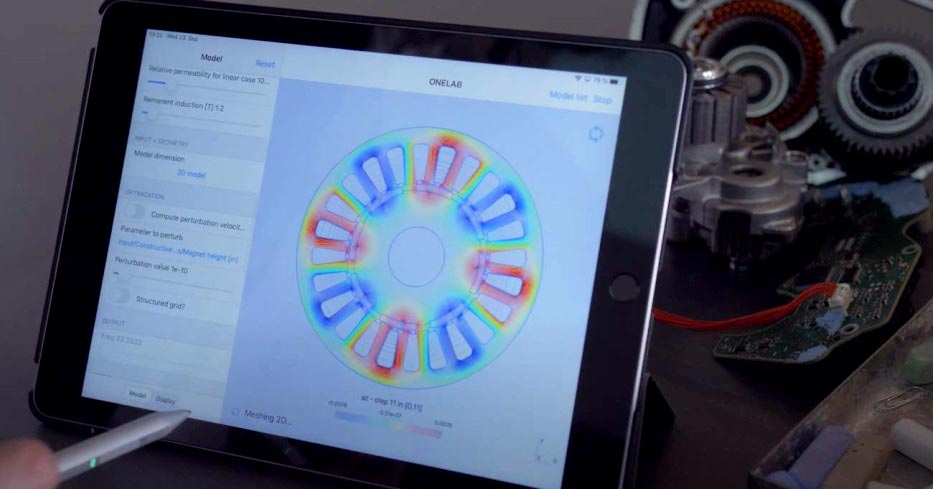
Optimizing Electrical Machines Through Computer Simulation

Computational engineering (CE) is used to optimise modern electric drives.
Picture: TUDarmstadt/HDA unter CC-BY 4.0
First German-Austrian Collaborative Research Centre/Transregio approved.
TU Darmstadt and TU Graz are intensifying their research into how electrical machines can be decisively improved through computer simulation. To this end, the first German-Austrian Collaborative Research Centre/Transregio (TRR) 361 has been approved. The German Research Foundation (DFG) and the Austrian Science Fund FWF are funding the TRR “Computational Electrical Machine Laboratory” with a total of over eight million euros.
For decades, electrical machines have played a central role in energy conversion, not only as generators for producing electrical energy, but also as motors, e.g. for electric vehicles. They account for more than half of total energy consumption. Modern power electronics have brought about numerous new operating and application possibilities for such motors, and together with new materials and manufacturing techniques, this opens up great potential for innovation. Supported by advances in design optimisation and control, new propulsion systems offer enormous potential for contributing to the achievement of climate targets.
Current design methods for electrical machines are based on a limited number of parameters and operating modes, typically at constant speed or constant torque, thus neglecting considerable optimisation potential. The scientists want to make use of this potential in the newly approved TRR 361 (“Computational Electrical Machine Laboratory. Thermal modelling, transient analysis, geometry description and robust design”).
The research work in Transregio 361 is carrying out a paradigm shift towards new integrated simulation and design approaches in order to exploit the potential of modern electric drives. These approaches take into account all important aspects of an electrical machine from the outset, for example shape and topology, time-dependent operating cycles, complex material behaviour, parameter uncertainties, robustness and noise generation, as well as new cooling techniques to push thermal limits. The modelling, simulation and optimisation of such a complex system poses extreme challenges for computational engineering (CE).
CE is an interdisciplinary scientific discipline with links to applied mathematics, computer science and engineering sciences, and has established itself as the third pillar of gaining knowledge in engineering alongside theory and experiment.
The approved TRR 361 project is the first joint German-Austrian research association in the funding line of Collaborative Research Centres (DFG) / Special Research Centres (FWF). In the future, the Technical University of Darmstadt (TU Darmstadt) and Graz University of Technology (TU Graz) will deepen and advance their joint research work on the simulation of electrical machines here. Professor Sebastian Schöps, head of the Computational Electromagnetics (CEM) Institute at TU Darmstadt, as spokesperson for the German side, and Professor Annette Mütze, head of the Electric Drives and Machines Institute (EAM) at TU Graz, as spokesperson for the Austrian side, have already been working together in this field for several years. The consortium of scientists from TU Darmstadt and its strategic partner TU Graz as well as Johannes Kepler University Linz includes not only proven experts in the participating subject areas but also numerous young scientists.
TRR 361 is closely integrated into the structures at both universities, such as the Centre for Computational Engineering (CCE) at TU Darmstadt and the Graz Center of Computational Engineering (GCCE).
About TU Darmstadt
TU Darmstadt is one of the leading technical universities in Germany and stands for excellent and relevant science. Global transformations – from the energy transition to Industry 4.0 and artificial intelligence – are being decisively shaped by TU Darmstadt through outstanding findings and forward-looking study programmes.
TU Darmstadt concentrates its top-level research in three fields: energy and environment, information and intelligence, matter and materials. Its problem-centred interdisciplinarity and productive exchange with society, business and politics generate progress for sustainable development worldwide.
Since its foundation in 1877, TU Darmstadt has been one of the most internationally oriented universities in Germany. As a European technical university, it is building a trans-European campus in the Unite! alliance. Together with its partners at the Rhine-Main universities – Goethe University Frankfurt and Johannes Gutenberg University Mainz – it continues to develop the Frankfurt-Rhine-Main metropolitan region as a globally attractive science area.
Background
Since 2017, the Technical Universities of Darmstadt and Graz have been working together at all university levels within the framework of a strategic partnership.









![[Figure 1] Schematic of next-generation CNT-PANI composite fiber supercapacitor and comparison graph with recent results](https://www.innovations-report.com/wp-content/uploads/2025/05/KIST_leads_next-generation_energy_storage_technolo_1746783279-e1746784635527-362x245.jpg)


